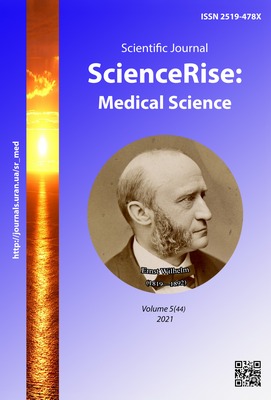A descriptive study of COVID-19 at a tertiary care hospital
DOI:
https://doi.org/10.15587/2519-4798.2021.238014Keywords:
COVID-19, descriptive study, tertiary care hospital, IndiaAbstract
Coronavirus disease 2019 (abbreviated “COVID-19”) is an emerging respiratory disease that is caused by a novel coronavirus and was first detected in December 2019 in Wuhan, China. The cases of COVID-19 infection since then were showing increasing trend in all over the world.
The aim: to study the epidemiological distribution and determinants of COVID-19 pandemic.
Methods: it is a descriptive study carried out at a tertiary care hospital of India. The population comprised of patients admitted in the hospital. Sample size comprised of all the subjects admitted in the hospital with established COVID 19 +ve cases. The duration of study was April 2020 to June 2020. The study was approved by the Institutional Ethical committee and Informed consent was obtained from each subject before the conduct of the study. Data collection was done by a pre-structured questionnaire. Data entry and analysis was done using SPSS version 20 software.
Results: out of total 38 COVID-19 +ve cases, 95 % were male and 5 % female ant the maximum numbers of cases ranges between 36–40 years of age group with the median age of 32 years.53 % of cases were Muslim and 47 % Hindu by religion. The median duration of stay in hospital of all COVID-19 +ve cases was11 day that on further differentiation with co-morbidity was 15 days and 11.5 without any co-morbidity. The median duration taken between 1st sample taken and report provided was 2 days, between 2nd sample taken and report provided 1 day and between 1st and 2nd sample taken was 11 days.
Conclusions: present study concluded that middle age persons were affected in majority which may be due to more exposure to public places. Co-morbidities are strong predictors of requirement for admission and duration of stay at hospital
References
- Zhong, B.-L., Luo, W., Li, H.-M., Zhang, Q.-Q., Liu, X.-G., Li, W.-T., Li, Y. (2020). Knowledge, attitudes, and practices towards COVID-19 among Chinese residents during the rapid rise period of the COVID-19 outbreak: a quick online cross-sectional survey. International Journal of Biological Sciences, 16 (10), 1745–1752. doi: http://doi.org/10.7150/ijbs.45221
- Bogoch, I. I., Watts, A., Thomas-Bachli, A., Huber, C., Kraemer, M. U. G., Khan, K. (2020). Pneumonia of unknown aetiology in Wuhan, China: potential for international spread via commercial air travel. Journal of Travel Medicine, 27 (2). doi: http://doi.org/10.1093/jtm/taaa008
- Lu, H., Stratton, C. W., Tang, Y. (2020). Outbreak of pneumonia of unknown etiology in Wuhan, China: The mystery and the miracle. Journal of Medical Virology, 92 (4), 401–402. doi: http://doi.org/10.1002/jmv.25678
- Du Toit, A. (2020). Outbreak of a novel coronavirus. Nature Reviews Microbiology, 18 (3), 123–123. doi: http://doi.org/10.1038/s41579-020-0332-0
- Ren, L.-L., Wang, Y.-M., Wu, Z.-Q., Xiang, Z.-C., Guo, L., Xu, T. et. al. (2020). Identification of a novel coronavirus causing severe pneumonia in human: a descriptive study. Chinese Medical Journal, 133 (9), 1015–1024. doi: http://doi.org/10.1097/cm9.0000000000000722
- Huang, C., Wang, Y., Li, X., Ren, L., Zhao, J., Hu, Y. et. al. (2020). Clinical features of patients infected with 2019 novel coronavirus in Wuhan, China. The Lancet, 395 (10223), 497–506. doi: http://doi.org/10.1016/s0140-6736(20)30183-5
- Bassetti, M., Vena, A., Giacobbe, D. R. (2020). The novel Chinese coronavirus (2019‐nCoV) infections: Challenges for fighting the storm. European Journal of Clinical Investigation, 50 (3). doi: http://doi.org/10.1111/eci.13209
- Zarocostas, J. (2020). What next for the coronavirus response? The Lancet, 395 (10222), 401. doi: http://doi.org/10.1016/s0140-6736(20)30292-0
- International Committee on Taxonomy of Virus (2020). Naming the 2019 Coronavirus. Available at: https://talk.ictvonline.org/
- Notice of the National Health Commission of the People’s Republic of China on revising the English name of novel coronavirus pneumonia (2020). Available at: http://www.nhc.gov.cn/yzygj/s7653p/202002/33393aa53d984ccdb1053a52b6bef810.shtml
- Gralinski, L. E., Menachery, V. D. (2020). Return of the Coronavirus: 2019-nCoV. Viruses, 12 (2), 135. doi: http://doi.org/10.3390/v12020135
- Phan, T. (2020). Novel coronavirus: From discovery to clinical diagnostics. Infection, Genetics and Evolution, 79, 104211. doi: http://doi.org/10.1016/j.meegid.2020.104211
- Cohen, J. (2020). Wuhan seafood market may not be source of novel virus spreading globally. Science. doi: http://doi.org/10.1126/science.abb0611
- Petrilli, C. M., Jones, S. A., Yang, J., Rajagopalan, H., O’Donnell, L., Chernyak, Y. et. al. (2020). Factors associated with hospital admission and critical illness among 5279 people with coronavirus disease 2019 in New York City: prospective cohort study. BMJ, 396. doi: http://doi.org/10.1136/bmj.m1966
- Xu, X.-W., Wu, X.-X., Jiang, X.-G., Xu, K.-J., Ying, L.-J., Ma, C.-L. et. al. (2020). Clinical findings in a group of patients infected with the 2019 novel coronavirus (SARS-Cov-2) outside of Wuhan, China: retrospective case series. BMJ, 386. doi: http://doi.org/10.1136/bmj.m606
- Guan, W., Ni, Z., Hu, Y., Liang, W., Ou, C., He, J. et. al. (2020). Clinical characteristics of 2019 novel coronavirus infection in China. doi: http://doi.org/10.1101/2020.02.06.20020974
Downloads
Published
How to Cite
Issue
Section
License
Copyright (c) 2021 Amit Mittal, Manoj Kumar Singh, Rajeev Kumar, Deepti Mandsorwale

This work is licensed under a Creative Commons Attribution 4.0 International License.
Our journal abides by the Creative Commons CC BY copyright rights and permissions for open access journals.
Authors, who are published in this journal, agree to the following conditions:
1. The authors reserve the right to authorship of the work and pass the first publication right of this work to the journal under the terms of a Creative Commons CC BY, which allows others to freely distribute the published research with the obligatory reference to the authors of the original work and the first publication of the work in this journal.
2. The authors have the right to conclude separate supplement agreements that relate to non-exclusive work distribution in the form in which it has been published by the journal (for example, to upload the work to the online storage of the journal or publish it as part of a monograph), provided that the reference to the first publication of the work in this journal is included.









